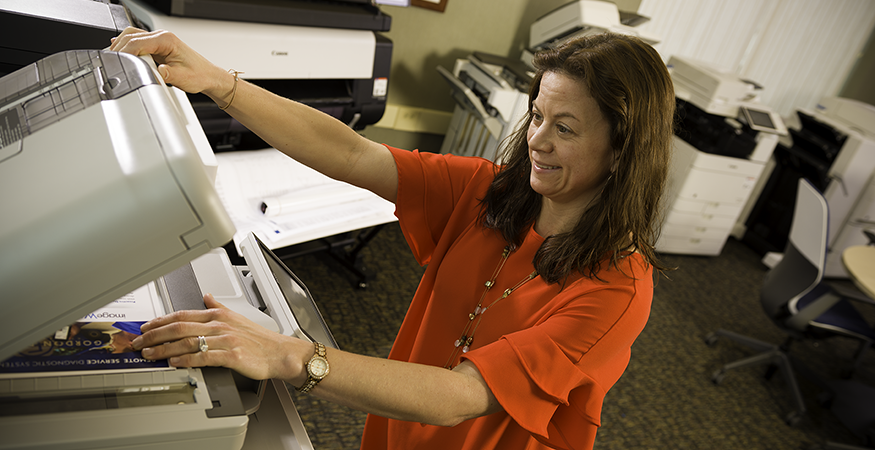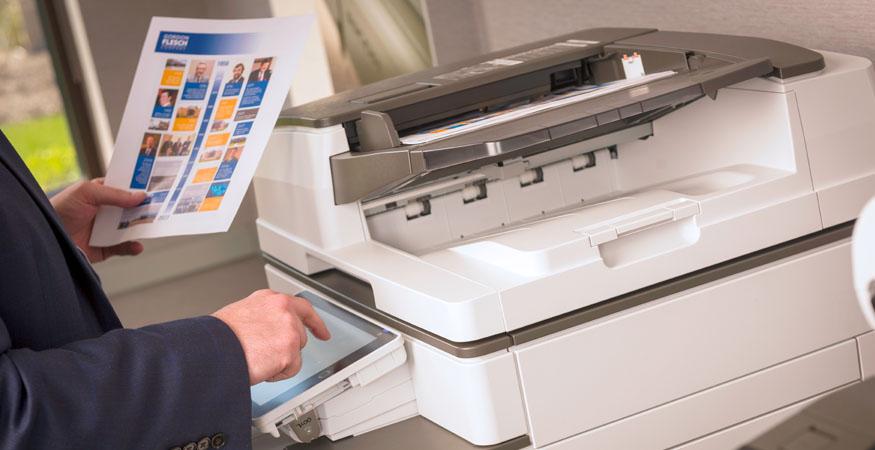Many organizations replace their office printers, copiers or fax equipment due to wear and tear or lease termination every four years or so. One way to manage procurement of new office equipment is to issue a Request for Proposal (RFP) to several Managed Print Service (MPS) providers. In fact, some government agencies are required by law to publish an RFP for any Managed Print Services contracts to be awarded.
What is a Managed Print Service RFP?
A Managed Print Service RFP, sometimes called a request for quote (RFQ), is a detailed business document that outlines a project’s product and service requirements with the goal of soliciting bids from multiple MPS providers.
The upside to an RFP is that multiple providers can compete for your business. The downside is that the responses to your RFP can be vague or confusing, making it hard to know whether you’re getting the best deal. While two proposals may look similar and use similar language, one may offer much more comprehensive services than the other.
That said, what parts of a Managed Print Services RFP should you pay closest attention to?
- Outline Goods & Services Costs
- Lease, Buy or Rent Print Equipment
- Include Printer Toner & Ink Cartridges
- Document Security & Compliance
- Conduct a Business Technology Needs Assessment
1. Outline Goods & Services Costs
Cost isn’t the sole determining factor when choosing an MPS provider. How those print costs are broken down and how you’re charged for goods and services is also important.
For example, cost per impression (CPI) models, sometimes referred to as cost per click (CPC) or cost per page (CPP), have users pay a set price for a base number of printed pages. As part of this model, the print provider can include:
- Delivery & installation of equipment
- Proactive maintenance & repairs as needed
- Supply management
- Employee training on how to use the equipment
Printers, copiers and related devices can be managed remotely to ensure they are working properly and serviced in a timely manner. A CPI model can deliver cost savings depending on the volume of prints your organization produces.
RFP TIP: Before putting your printer RFP out for bid, consider the volume of printing and copying your staff does in any given year. Ask prospective bidders to offer multiple contracts based on different pricing models to see which makes the most sense based on your actual usage. Also determine the breadth of service provided and what your all-in costs are, including service, repairs and supplies. Don’t forget about cloud printing to ensure your remote workers have easy access to print devices.
2. Lease, Buy or Rent Print Equipment
Consider whether it is in your interest to lease, own or rent equipment. Many businesses own their printers, but soon realize they have no flexibility to upgrade it until the device is fully paid for. They might also end up spending thousands of dollars in repairs over time.
A lease agreement makes it possible to renegotiate your contract or adapt to new technology quickly. Lease terms typically span between three and five years. This finite time period typically leads to upgrading your copier equipment at the end of your contract term.
RFP TIP: Consider how much upfront capital you’re willing to spend. Leasing office equipment provides flexibility and also offers a fixed monthly or quarterly price. Be sure to specify whether you want the option to purchase the equipment when the lease term is up. Also ask whether the MPS contract billing can be broken down by individual departments or users.
3. Include Printer Toner & Ink Cartridges
Keeping track of printers and supplies can take a lot of people power. An MPS provider can monitor toner levels and handle purchasing and replacing them when the time is appropriate.
Consider how much toner and supplies cost your business and whether to work with an MPS provider that delivers supplies based on your needs. A just-in-time toner service ensures you don’t run out and helps to eliminate supply storage space in your office.
RFP TIP: Inquire whether an MPS provider offers remote monitoring software to report on the real-time status of your networked devices and whether email alerts can be set up for toner status and various device errors.
4. Document Security & Compliance
Document security is especially important in fields such as healthcare, where strict HIPAA privacy laws restrict the dissemination of patient information. A good Managed Print system offers software that optimizes business processes and keeps important documents secure from hackers and internal threats. This includes running detailed reports of usage based on swipe-to-print technology. A provider should also be able to wipe documents from a printer’s memory when necessary.
Ask bidders if they provide software updates and security services. Do they have remote monitoring to ensure software and security updates are in place? Also include language that ensures the bidders will remove hard drives from old printers and multifunction devices and destroy information that might be left on them. A vendor should also be able to provide a certificate of destruction, certifying that any information stored on your printers was wiped and/or destroyed.
RFP TIP: Ask your vendor what it costs to implement security and swipe-to-release features that make your fleet more efficient and secure. Adding proximity card readers or security codes might cost more at startup, but over the long run will cut down waste and make it much more difficult for confidential information to be taken off a printer without authorization.
5. Conduct a Business Technology Needs Assessment
Most business professionals aren’t immersed in the printing industry to fully understand what options or management service models are available for their print environment. As such, an RFP may include too many machines, too few or miss critical features and information.
At Troyka-TC, we recommend conducting a thorough print assessment prior to developing an RFP. This assessment will:
- Identify all existing office copiers, printers & scanners
- Classify locations where all office equipment is stationed
- Determine the volume & type of work generated by the business
- Detect the current software used
- Evaluate the labor, maintenance, supplies & costs of all in-house printing operations
- Determine compliance requirements
After the initial assessment, the MPS provider will develop recommendations based on your unique needs. It’s not uncommon for some organizations to actually reduce their printer fleet (and overall cost) based on these recommendations. In fact, many discover that if they change from a simple equipment replacement strategy to a Managed Print strategy, they can reduce the total cost of print from 10 to 30%.
RFP TIP: Ask the vendor how regularly they meet to deliver updates, assessments and plans for ongoing improvements to your fleet. Also, ask what software they use for monitoring and reporting. The software should track usage and deliver detailed reports that let you maximize the use of your print machines.
Lastly, it’s important to look at your RFP as the foundation of a long-term relationship with your Managed Print provider who will align their equipment and services with your strategic goals.
Whether going through an RFP process or simply considering a new printer purchase, contact us to request a complimentary business technology needs assessment. We’re here to help.










